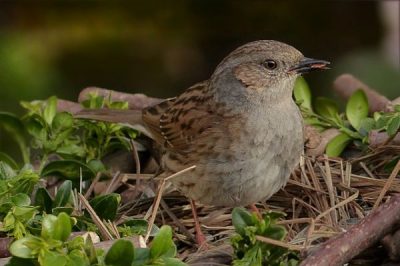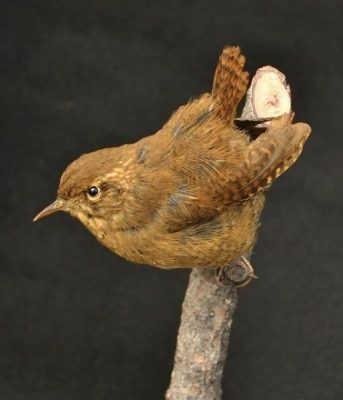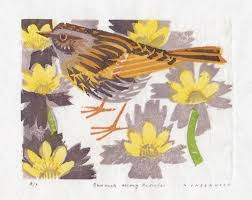Do you have a problem working out just what little brown bird you are looking at? I do!
So I have been looking at the RSPB chatroom on this subject and found the following really useful:
It takes time to get to know what you need to be looking for to identify different species – and it can often also take time before beginners start to actually pick out some of the details that they need to note, even if they know what they need to look for.
One of the first things to start looking for is the size and shape of the beak, this will immediately narrow down the families of birds that a mystery bird could belong to.
The next thing is to make sure that you always compare and contrast unfamiliar birds with birds that you are already familiar with – if it is very similar it is quite likely to be in the same family (or a closely related one).
This Blog is part of the DIVERSIFLY project: For more details on the project go here

Dunnock from Pixebay
For years I have been wanting to identify a dunnock… I thought I had never seen one, but in fact I just hadn’t identified it. The first time I finally made the breakthrough was when I was watching a pair of little brown birds during their mating process! They looked very like sparrows but ‘prettier’ and ‘less-like bullies’… I think its a lot to do with their thin insect-eating beak; they are about the size of a sparrow with sort of the same marking but ‘faded’… this is not an official description, just what I noticed. Every morning we do 12 minutes of Chi Kung standing exercises before going on to do the Tai Chi long form… I see so much during those 12 minutes – as I station myself in front of our patio doors that look out to the birdfeeder, some steps and a pond. On this particular day I noticed one little brown bird following the another little brown bird. The first bird was moving its (I assume her) tail very very fast – up-and-down,up-and-down – like a humming birds wings; he, behind, was getting more and more excited… At the top of the steps she presented her bottom to him – lifting her tail and her bottom – and then HE started to peck at her “opening”. I had read that some birds do this – they are pecking out the sperm of previous males – but I had never ever seen it before. She started moving her tail really really fast and inbetween more pecks he moved around excitedly as if he was on hot coals – and then suddenly it was time – and he – well, he totally fluffed it. He sort of flew at her and away and hid beneath a bush and she had to coax him out and encourage him and get him to do the whole process again. He fluffed the second attempt too… all I can think of was that he was a young dunnock and this was his first attempt… he flew off with the female hard on his heels… I’m sure she got him in the end but I didn’t see that.
I don’t think I will forget what a dunnock looks like in a hurry!
Dunnocks used to be called the hedge sparrow: ‘sparrow’ was the name given to any small bird in the past. Dunnock was revived as its name fairly recently – it was also known as a hedge accentor.
They fly in a jerky way at low level and spend a lot of their time either on the ground or on fences.
There are actually two separate British species of sparrow: House sparrows and tree sparrows. I have a lovely book by Shrewsbury-based Matt Sewell called “Our Garden Birds”He describes a House Sparrow (Passer domesticus) as an old RAF Squadron Leader in flat cap and tweed; and the Tree Sparrow as a country gentleman that matches a chestnut-brown flat cap with his tweeds and prefers to congregate with his cohorts in woodland, farmland and gardens; rather than car parks and high streets preferred by the House Sparrow. From his description I can tell the photo below is os a Tree Sparrow… His drawings are childlike – they are charming and incredibly useful in identifying birds, I’ve found! I’m sure everyone can recognise a sparrow – and sees them regularly in every British town and city; aswell as at beach bars and restaurants abroad!
This everyday encounter was sent in, kindly, by Anne Harding:
My friend and I were walking to the supermarket in Stirchley when we spotted a male sparrow on the top of a chapel roof. It was searching for insects in the guttering. As we looked up it began its ‘cheep, cheep, cheep’ song and then flew away into the bushes nearby.
Here is an excellent you tube video on the House Sparrow by Mark Barkan of AviBirds.com who has given permission to include his video here.

Sparrow from Pixebay

Wren from Pixebay
The wren is a gorgeous creature. Again from the RSPB chatroom:
One of my favourite LBJs is the Wren. One of our smaller birds but with a big voice. ID features to look for , as well as the small size , are the cocked up tail and the pale eye stripe. Mostly seen close to or under bushes but will fly to a high perch to sing.
The wren is the second smallest of our regular breeding birds (it is only a quarter of an inch larger than the goldcrest)
Both male and female are known as the Jenny Wren.
The male often builds several nests and then gets its mate to select one. We once had a wren nest on the top an old hospital screen in the garage – they are described as domed nests – of moss, leaves and grass; and the females line them with feathers.
You may have seen the very cute photos of seemingly a hundred wrens all huddling up in a half coconut shell – because of their tiny size they are very prone to the cold and suffer heavy losses in hard winters.
And apparently on December 26th youths used to beat the hedgerows, singing and trying to kill any wren they saw. Humans. Honestly!
Wrens are really common, I often mistake them for mice – they run along the ground in a very mouse-like way. A friend came to stay and said what was that! It looked like a mouse! And so we put him right and told him it would be a wren. Same time next day we all saw the mouse, which wasnt a wren on this occasion.
Here are some poems about Little Brown Birds. I love Norman MacCaig’s poetry so was particularly happy to find this one! :
There was an old person of Hove –
There was an old person of Hove,
Who frequented the depths of a grove;
Where he studied his books, with the wrens and the rooks,
That tranquil old person of Hove.
SPARROW -Norman MacCaig
He’s no artist.
His taste in clothes is more
dowdy than gaudy.
And his nest – that blackbird, writing
pretty scrolls on the air with the gold nib of his beak,
would call it a slum.
To stalk solitary on lawns,
to sing solitary in midnight trees,
to glide solitary over gray Atlantics –
not for him: he’s rather
a punch-up in a gutter.
He carries what learning he has
lightly – it is, in fact, based only
on the usefulness whose result
is survival. A proletarian bird.
No scholar.
But when winter soft-shoes in
and these other birds –
ballet dancers, musicians, architects –
die in the snow
And freeze to branches,
watch him happily flying
on the O-levels and A-levels
of the air.
Here are some images I have found online:





And here are a few links with some more information :
Telegraph article on the Dunnock
RSPB on the sparrow family – which they describe as finch-like birds
BBC on the Wren – in which they say it is Britain’s most common breeding bird
Nadia x
 This Blog is part of a series of Blogs that are part of the Fair Acre Press project – DIVERSIFLY: everyday encounters with the birds of Britain’s towns and cities. For more details on the project go here
This Blog is part of a series of Blogs that are part of the Fair Acre Press project – DIVERSIFLY: everyday encounters with the birds of Britain’s towns and cities. For more details on the project go here







No comments yet.